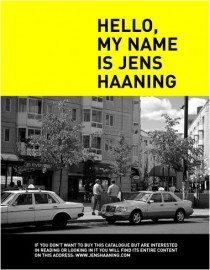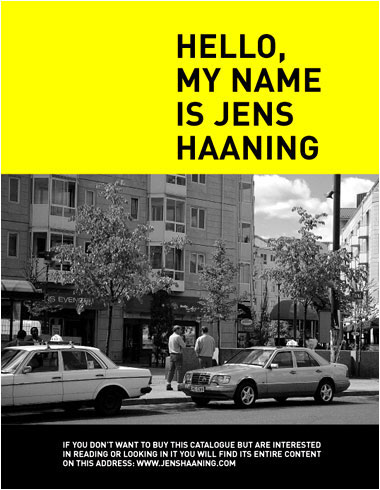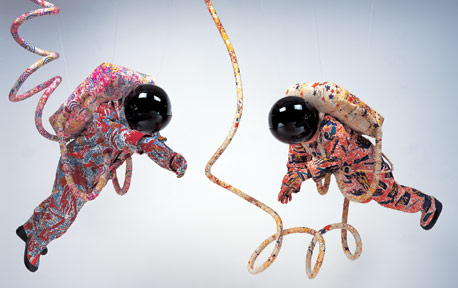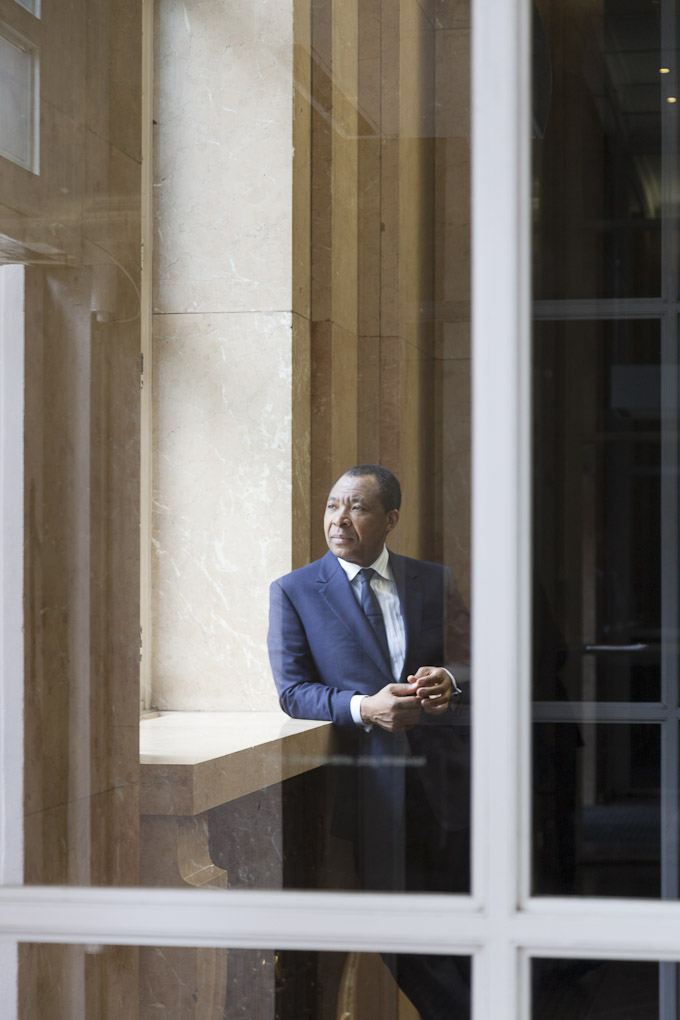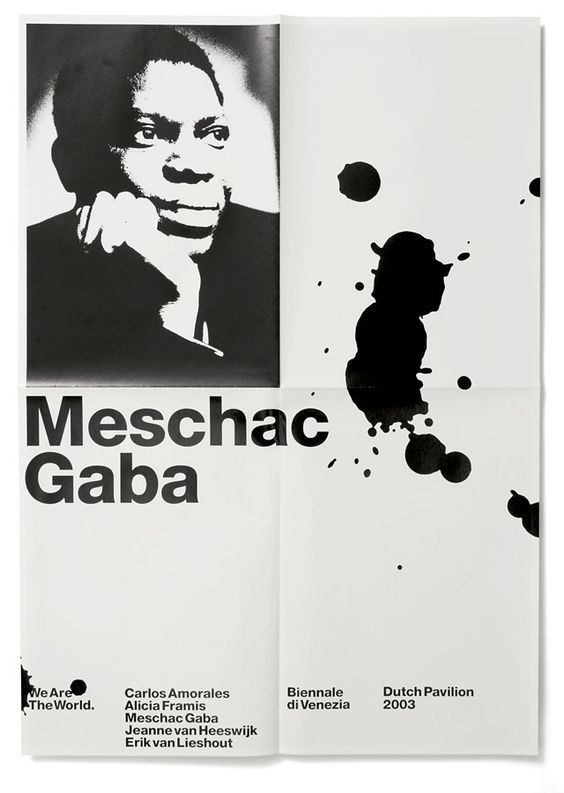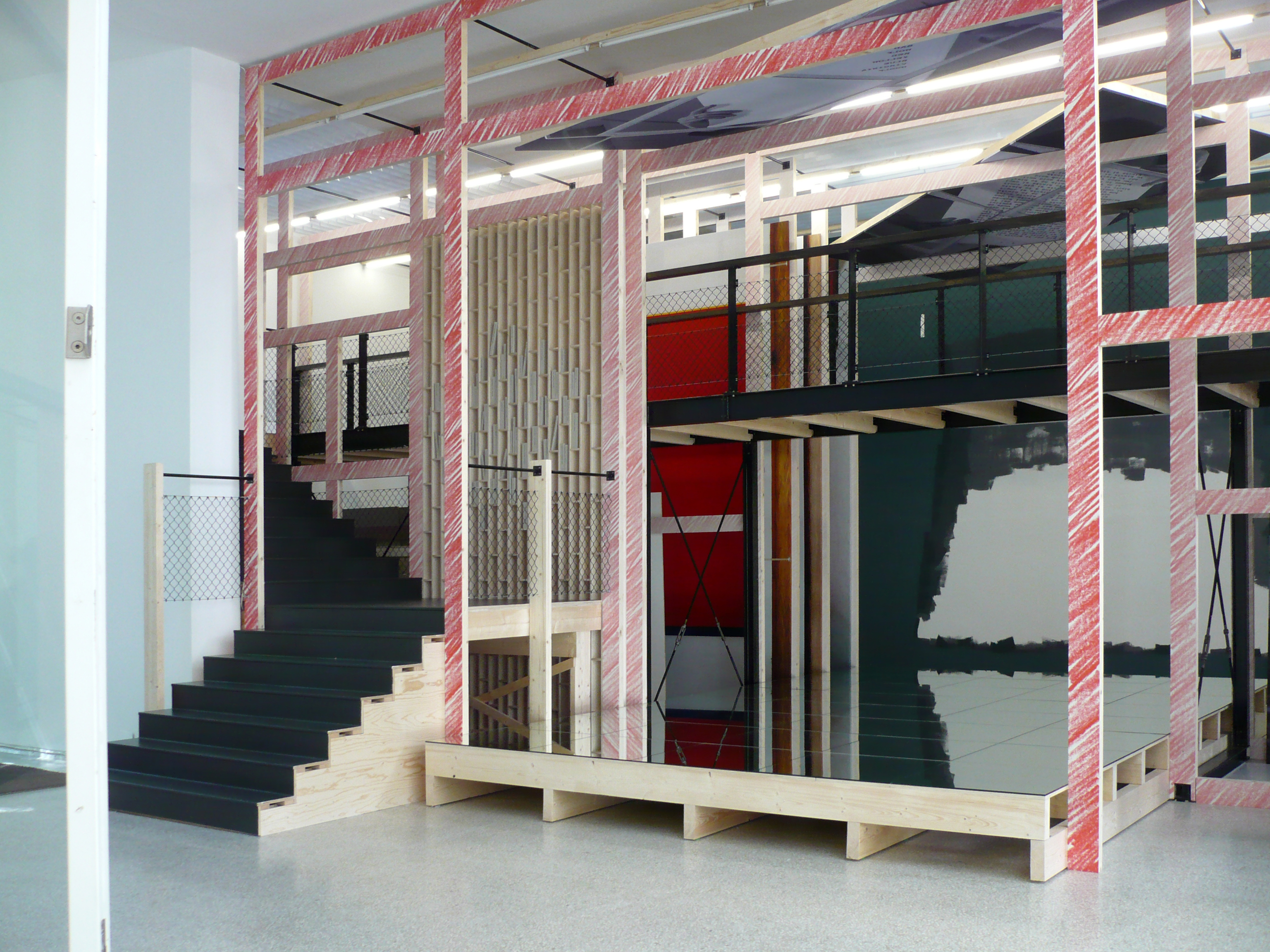ARTICLE – APRIL 2002
ADMITTED
by Nina Folkersma
published in Hello, My Name Is Jens Haaning, © Les Presses du Réel and Jens Haaning, 2003
1. HE WAS THERE FOR ONE YEAR. TWELVE MONTHS, TWO WEEKS AND ONE DAY, TO BE EXACT. He tells me that it went wrong in Paris. That then he had gone back to Denmark. And that there he was admitted to the psychiatric ward of a hospital in Copenhagen. The Rigshopitalet. The same hospital where the Danish filmmaker Lars von Trier had made his twelve part soap-slash-horror television series, The Kingdom. I can imagine how he wandered through the labyrinthian corridors of that enormous building, which once was the most advanced hospital in the Kingdom of Denmark. And I wonder if he, too, heard the screams of the dead girl, Mary, the illegitimate daughter of one of the hospital’s founders, the infamous Dr. Krüger — the girl who people here say was murdered by her own father in 1919. They say that the psychiatric patients in The Kingdom can still hear her screaming to this day.
He tells me more. Says that in retrospect he realized that it had in fact already started at the age of five. The ups and the downs. By the time he was admitted at the age of 32, his condition was, as he himself puts it, ‘pretty heavy’. The light tone in which he states this makes me suspect that the term is rather euphemistic at that. Again I try to imagine it. What it must be like to feel like Superman one moment — flying above the earth in your red and blue suit, cape waving — and crashing to the ground the next. Feeling pulverized by a world that is suddenly as dark and obscure as Batman’s Gotham City. I am reminded of my own adolescent years, the period in which I went through a heavy identity crisis and identified with — “himmelhoch jauchzend, zu Tode betrübt” — the young Werther or with Madame Bovary.
His Sturm-und-Drang periods usually recurred once every six months. In a ‘good year’ each of these periods lasted for two, three months. The energetic periods were fantastic, naturally. The things that he could do then! His production was phenomenal. Those phases more than compensated for the lethargic months when nothing emerged from his hands. Again I see him flying, the world at his feet. And I try to imagine that one perfect moment, right before the fall. That moment when the air falls out from beneath your wings, but you still remain floating. That serene peace, when time seems to stand still for an infinite moment. But then comes the fall, inevitably.”The art is to fall so fast that you fly past yourself and are just in time to catch yourself.” wrote the Dutch poet K. Michel. Most people do not fall so fast. Often they manage to recover their balance in time.
Jens fell. In Paris, in 1997. And Jens was no longer capable of catching himself. The Danish hospital made the diagnosis: manic depressive psychosis. And that was it, then: a clinical picture, a label, a method of treatment, medication. Suddenly he was a patient. Someone who had been pigeonholed. And then tidily locked away in a little room and temporarily placed outside the society. Powerless and dependent, because of something that was beyond his control. The way back lasted one year. It might have been worse, runs the thought through my mind. But then he says, in the same soft tone of voice, that he once calculated he had spent a total of ten years in bed and that for approximately half of his life he has been severely depressed.
2. NATURALLY, HE READ FOUCAULT.
He was already interested in the workings of power and its influence on the individual during high school — although at the time he did not yet use those terms. Then it was simply called ‘who belongs’ and ‘who’s an outsider’. As a teenager he was involved with political activities. There he noticed how some people were able to readily adapt to the system, how others were shut out and how some of them subsequently tried to overcome their underdog position by exercising power over others. Yet that was not the reason why he left politics and later on took up art. As a political activist, he too often felt forced to come up with concrete solutions, whereas art offered him more room for analysis and the formulation of reflective questions. That freedom appealed to him: he wanted to create frameworks that other people could use in order to investigate and sharpen their own views of the world. At the art academy, he again became engrossed in Foucault and his ideas about power and control. Like Foucault, he was not interested in power itself, but in its opposite: powerlessness — the mainspring behind every form of extremism. He was particularly interested in different forms of resistance, in groupings — often minority movements — which were outside the law or the social system.
I dig into my memory, rummage through my bookcase and try with all my might to unearth the remnants of my knowledge about Foucault. I recall Foucault’s preoccupation with prisons, hospitals and lunatic asylums — institutions where the invisible mechanisms of power are visible in the architecture. And I remember Foucault’s Madness and Civilization and Birth of the Clinic, in which he describes how madness has been regarded throughout the ages. Up until the 19th century, madness was not considered to be a mental illness. Only in modern times — when the morality of the church were replaced by that of science — was the idea of insanity as a psychic disorder born. From that moment on, lunatics were hidden away in institutions, under the pretext of letting them recover in peace, but in fact in order to protect society against them, says Foucault. And so the new scientific disciplines of psychology and psychiatry are at the service of society, which aims at excluding those who do not conform to the ‘normal’, according to Foucault.
Had Jens recognized himself in this? He says that in Foucault he recognized his own fascination for the subject, but not his own condition. He simply never had put two and two together, he declares laconically. In his first years at the art academy, in and around 1990, he indeed made work that dealt with a kind of psychological angst or a feeling of oppression. Life-sized objects they were, exactly the size of his own body, pressed-together pieces of wood or heavy metal, with soft foam rubber in between. A Danish art critic, Anne Ring Petersen, noted with due propriety that this work was about “existential confinement, bodily torment and psychological pain”. And in 1993 he made a series of multiples of plastic bags filled with medication that could only be obtained by prescription. Hand-me-down pills, 50 grams to a bag (Candy Bags, he called them). Exactly enough for an “extremely long lasting flight from reality”, as Ann Ring Petersen put it.
After he had studied for a year at the Academy of Visual Arts in Munich, his work became more aggressive, more outwardly directed. Instead of creating a represen- tation of a feeling of oppression, he tried by means of installations and actions in public spaces to arouse a direct, psychological reaction in the spectator. By using threats and intimidation, for example — like the Watch Out piece he made in collaboration with Magnus Wallin in the gallery of Nicolai Wallner. The only thing he exhibited there was a pair of German shepherds on long chains. Try staying cool and collected when two such animals start barking dangerously at you. Or the installation Trap, which I ‘fell into’ in 1994 during an international exhibition of young artists in Breda. I stepped into the empty space through a sliding metal door, which slammed behind me with enormous force and then remained shut for roughly 45 seconds. Talk about psychological angst in relation to confinement.
Analytically inclined people often have a blind spot toward their own condition. Doctors ignore their own diseases, psychiatrists deny their own neuroses, and Jens overlooked the fact that an artist can also be the subject of his own work. His first confrontation with the personal nature of his work was head-on. He crashed into a trusted but unknown world, with new insights and significance. Only after his stay in the hospital did he realize the full import of what he had made all those years. He asks if I would like to examine his work from this angle now, because he believes it also throws a new light on his other work. But, he impresses upon me, his work is certainly not autobiographical. Please, no self-therapy! Now, I am not an adherent of the view that the artist is a tormented soul who expresses the innermost stirrings of his or her being. But how do you describe the psychic dimension without crawling into someone’s psyche? Without identification, without heart and soul?
3. “THE IDIOT IS THE HUMAN BEING OF THE FUTURE; RELEASING THE IDIOT WITHIN YOU IS THE KEY TO HAPPINESS.” In the film The Idiots by the same Lars von Trier mentioned earlier, Stoffer at one point asks: “What you do about a society that grows richer and richer, but in which no one grows any happier?” To make it easy, he gives the answer himself: “You play the fool.” The film is about a group of people led by Stoffer who decide to resist society and its social norms by pretending that they are mentally handicapped, and by acting like idiots. Lunacy as a form of liberation and as a model for resistance — also a beloved theme of philosophers. Bataille described — or, to put it better, personally understood — madness to be a borderline experience, an experience of the disorderly alien. Foucault described madness as that which is always excluded, as the dangerous Other. And Deleuze & Guattari relate the subversive to schizophrenia. For them, the schizophrenic is a radical, revolutionary figure who resists the repressive power of the capitalistic system.
Two years ago, the curators of “Manifesta 3” in Ljubljana took the notion of ‘borderline syndrome’ as their departure point. They construed that notion, which derives from psychiatry and indicates a personality that has severe problems in defining its own identity, as a metaphor for Slovenia’s position in the new Europe. And, more generally, for our present culture, which posits, crosses or eradicates borderlines at all possible levels of discussion. I like metaphors. Preferably as personal as poetry, as intimate as a dream. But to my mind, it remains a delicate question to treat a severe psychiatric disorder as a metaphor and, as in the case of “Manifesta 3”, to transpose it to a concrete political situation. In the case of Deleuze & Guattari, the question — not withstanding the charm of their radical schizophrenic — is how a figure like that can resist capitalism. Even if he does not take part in “the hyper-consumption of late capitalism”, he can hardly be termed a revolutionary. With Lars von Trier, too, the use of a mental handicap as metaphor has something decadent about it. In The Idiots — certainly his best film, says Jens — Stoffer drops his role as idiot at one point. Frustrated by the reactions of the surrounding world, he proposes that the group go home and give up the experiment. At that moment, it becomes clear that this group of ‘idiots’ can throw off their aberration and return to ordinary society whenever they wish. A luxury that Jens does not have.
Nor do the patients in the psychiatric hospital De Gelderse Roos in Amsterdam have the possibility of voluntarily stepping out of their situation. However, Jens did offer them the opportunity — via a live hook-up — to take a peek into the art institution De Appel in Amsterdam. As his contribution to the “Plan B” (2000) exhibition, he placed a small video camera in one of the rooms of De Appel, that broadcast directly to De Gelderse Roos, where the images could be seen on all of the hospital’s televisions and computers via its internal audiovisual network. A connection between one white sterile space where the observing ‘clinical gaze’ reigns supreme, and another. Two institutions where something is placed outside society and rendered ‘harmless’. The parallels are clear. But what about the metaphors? Does Jens treat his own psychic history as a figure of speech? Perhaps he uses his work — if it is not autobiographical — in a metaphorical sense: to make clear that the artist, like the psychiatric patient in an institution, is confined and excluded. That his transgressive or subversive actions are also isolated and neutralized.
4. HARDLY ANY IMMIGRANTS LIVE IN DENMARK.
Everyone always thinks that Denmark is such a friendly country. Small and orderly. Cities, expressways, streets — yes, even nature — all neatly arranged. A trim little Legoland. But what many people do not know is that the current government is planning to make salaries contingent upon a person’s national origin. I hear my own dismay reflected in his voice. He speaks of an ultra right-wing government, which judges on the basis of skin colour, which tramples upon the UN conventions, which is tacitly creating a country full of eerily normal xenophobes. And I hear his silent, intense anger.
Often he is typified as ‘that artist who specializes in migrants, refugees and asylum seekers’. He himself prefers to see it in a broader sense, look a bit past that. After all, you see things better when you look at what lies beyond the borders. Think of Foucault, who was able to define modern society sharply by training his gaze precisely on what it excluded; that which does not fit within the order of the rational and the ‘civilized’. Jens also looks at the outsiders and the excluded. At those who live at the edge of society — often literally: at the edge of the city, in safely fenced-off buildings, in asylum centres or psychiatric institutions. Right before Christmas last year, I received a package in the mail from him. A calendar for the coming year. Very simple, almost businesslike in design. A separate page with photo for each month: a portrait of a young couple in the park, a family at a playground, two young men on the porch. Normal people, nothing exceptional. But the title of the calendar reveals a snake in the grass: The Refugee Calendar (2002). It proves to be portraits of people who have asked for asylum in Finland, and at the moment of being photographed are still waiting for the answer to their request. A year earlier, he had made a comparable series of photographs. Portraits of first generation refugees in Copenhagen. Each photo is accompanied by a short text: a detailed description of the clothing and accessories that the subjects are wearing, plus the price that they paid for them in Danish krones. Antonio wears a pair of secondhand pants by Kansas (35 DKK), underwear by Calvin Klein (250 DKK) and his mobile telephone is a Motorola (500 DKK). Deniz has also ‘adapted well’ to ‘our Western dress codes’: he wears Adidas training pants costing 200 DKK and a Benetton sweater that he picked up in Turkey for the equivalent of 80 DKK.
I leaf further through the documentation and come across Brian, Knud and Caya. The same portraits, the same facial expressions. And neither do I discover any appreciable differences in clothing or price. Yet this is a different group of people here. The caption declares that they are psychiatric patients who live in Copenhagen. Suddenly an uncomfortable feeling comes over me. Migrants and ‘the mentally disturbed’ may indeed both be kept outside the system — but ranking them together is going too far for me. Doubts that I had had earlier now return. Sometimes I have difficulties with artists who are actively engaged with — to put it in a generalized way — certain minorities. Every once in a while I suspect these artists of being stuck in thinking in antithetical terms. Or worse yet: that they uphold and maintain opposites and contribute to polarisation. Every now and then I also feel this in Jens, the overly rigid antithesis between power and powerlessness, between haves and have-nots, those in authority and outsiders. I catch myself relating such antithesis to his bipolar disorder. Would that have something to do with it? No, now that I write this, I realize how presumptuous the thought is. And I realize that this is the danger in naming the unnameable. In reducing the ‘disorderly alien’ to the familiar. Captured in words, in paper theories, his projects can indeed seem like a simple matter of addition. One plus one soon adds up to a category. From personal experience, I know that in reality his work is more confusing and ambiguous, even more light-hearted. I recall Bordeaux, where on a street corner in the Arab district I was confronted with my own assumptions about the Arabian culture. Through a loudspeaker that Jens had mounted on a lamppost, I heard different Arab inhabitants of the district telling jokes in their own language. Thus, completely unintelligible to me. Were the jokes good or insipid, racist or sexist? The only reference that I had was my own pattern of expectations. And that was exactly what Jens was pointing out with this project. Ha!
5. THE HUMAN WORLD IS A SYSTEM OF CONTRADICTORY MOVEMENTS.
Human thought occurs by way of antitheses, to which we add mutually hierarchical relationships. But thought cheats. It secretly assumes that those hierarchies also actually exist, whereas in fact they are a succession of perspectives, telescoping into or over one another. Often smoothly, sometimes by fits and starts and every once in a while in head-on confrontation. Our thinking is driven by these confrontations, not so much by the antitheses themselves as by the insolvable tensions between the various positions. Normal, healthy, rational, civilized. Or is it irrational, criminal, fugitive, alien? Bataille called it ‘human’. He noted: “the notion of the human therefore never implies (…) an unambiguous position, but a precarious balance, specific to the quality of ‘humanness’. Human dignity always allows a combination of mutually contradictory movements.”
After a long while, I see Jens again in South Korea. It is the end of March 2002, and he and I are here for the occasion of the opening of the 4th Gwanju Biennial. He has just come from Thailand. The Asian spring sun has added an extra ruddiness to his already freshly ruddy face. He has made a new work especially for the Biennial: a water exchange project between the cities of Gwangju and Imgingak. On the day of the opening, he and a Korean chauffeur depart from the Biennial terrain in a large freight truck filled with water. The journey to the North will take about eight hours. In Imgingak the truck will empty its contents in the public water system, to be filled again with local water. Upon returning to the Biennial terrain, this water will then be dumped into the drainage system of Gwangju. Clear, simple. But the undertaking is less innocent than you might think. Imgingak is the last South Korean city before the border with North Korea. Jens tells me that just hearing the name of that city evokes mixed feelings in the South Koreans, who officially are still at war with the Communist North. Again he knows how to touch a sensitive political nerve.
Yet even so. Even so, I feel that this work is sooner poetic than political. In any case, I have the impression that his work has become friendlier, gentler in the last few years. Weapons, flags and dogs — attributes in the earlier work — have made way for water, foodstuffs and free admission. Such as in Foreigners Free — Biel Swimming Pool, a project in the Swiss city of Biel, where he arranged for the local swimming pool to grant foreigners free admission. Or in Super Discount, at the Centre d’Art Contemporain FRI-ART in Fribourg, where he offered for sale at tax-free prices foods such as salami, cheese, cake and pasta. He had bought the foodstuff in France, paid taxes at the border, and imported it to Switzerland. In FRI-ART, visitors to his exhibition could do their grocery shopping at prices 35% less than normal. These actions throw a mischievous wink at social structures and economic systems, but ultimately they are sooner generous than conflict-arousing.
Back in Gwangju. Jens and the Korean chauffeur have safely returned from their ride to Imgingak. Twice they have shared each other’s company for eight hours, cooped up in the cabin of a truck. I try to imagine how they communicated. Jens, who knows nothing of the Korean language or signs, with a head full of questions about the country passing him by; and the Korean chauffeur, who does not speak one word of English, full of thousands of questions about the artist’s work. Both of them cut off from each other’s world. How do you bridge the distance, the contradictions? I can picture it before my eyes. The chauffeur making gestures, pointing left and right, miming the words. Jens nodding his head and answering with his eyes. Empathizing, sympathizing.
Translated from Dutch by Jane Bemont, Amsterdam.
You can download the full catalogue of Jens Haaning here
ISBN 2-84066-082-2
Edited by: Vincent Pécoil and Jens Haaning.
Publisher: Les Presses du Réel / Xavier Douroux and Franck Gautherot, 2003.
Produced by: Le Consortium Dijon in collaboration with Centre D’Art Mobile Besancon and Danish Contemporary Art Foundation.
Graphic Design: SIZEFICTION.COM (Copenhagen)
© Les Presses du Réel and Jens Haaning, 2003
